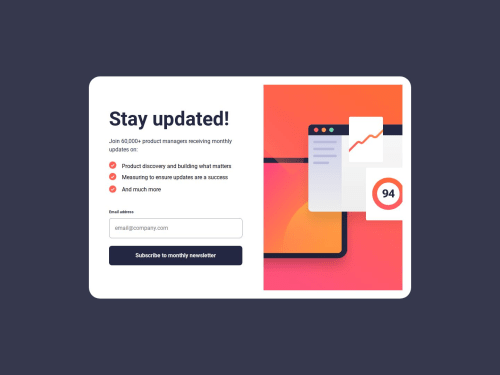Newsletter_sign-up_form_with_success_message( Javascript )

Solution retrospective
I started with the design of the mobile version, then the success message and then I adjusted the media queries for the desktop version, once the whole structure was perfectly finished, I started on the javascript part. At first I was really overwhelmed, I didn't know where to start but by listing my needs and how to proceed I was able to find a solution that wasn't too complex. I probably should have done things differently on how to hide the main container, I modified the display directly in the css with javascript, I probably should have added a .hidden class but I didn't have the courage to start again.
What challenges did you encounter, and how did you overcome them?Figuring out how to change the border radius directly in the svg file so that it fits the design, I searched a bit. This is by far the most complex project I've done so far and yet it's really a small project on a single page, with little interaction, I realize how far I still have to go. travel and it feels like climbing Everest sometimes, but small steps by small steps, I progress at my own pace.
What specific areas of your project would you like help with?All advice is welcome, especially on how I structured the project, I am curious to see if there was simpler or how others have proceeded, I would perhaps look at other projects to learn an idea. The JavaScript approach is still a big gap, even if I understand the language, sometimes I have a lot of trouble articulating the functions together.
Please log in to post a comment
Log in with GitHubCommunity feedback
- @petemac281
You did great. I'm just starting out, but I look at some of what you did and it gives me thoughts about how I can make my own projects better.
Join our Discord community
Join thousands of Frontend Mentor community members taking the challenges, sharing resources, helping each other, and chatting about all things front-end!
Join our Discord